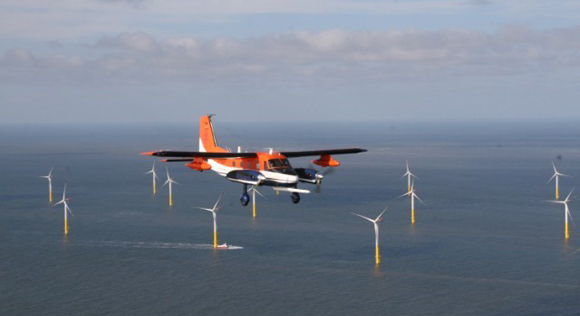The wind of change
Offshore wind energy is key for the energy transition. However, the more wind farms are being constructed, the more offshore wind energy changes. By flying over the sea at low altitudes and using images from space, researchers are looking into the effects of this on offshore expansion.
 © Mark Bittner / Technical University Braunschweig
© Mark Bittner / Technical University Braunschweig
A research aircraft flies at low altitude over the German Bight, with the turbines of hundreds of wind farms rotating below. The research team aboard the plane uses special measuring technology to analyse the wind flows from the turbines that occur downstream and upstream of the wind farms. These flows change the wind conditions in the Bight and cause quite a bit of turbulence. This has an impact on the parameters that need to be taken into account as offshore wind energy is expanded, such as the ideal positioning and orientation of new turbines. The research teams which form part of the X-Wakes research project that was launched at the end of 2019 are seeking to predict as precisely as possible how the wind conditions in the German Bight could change if offshore wind energy is expanded on a large scale. As the energy supply increasingly shifts towards renewable energy sources, harnessing offshore wind energy is becoming more important. Offshore winds are steadier and smoother than onshore winds. In the German economic zone in the North Sea alone, more than 1,200 wind turbines had been built by the end of 2020.
The German Bight is located on the European continental shelf, covering the West Frisian Islands (in the Netherlands), the East Frisian and North Frisian Islands (in Germany) and the Danish Wadden Sea Islands close to Jutland (in Denmark). An overview of the German wind farms that are located in the German economic zone can be found here.
X-Wakes is to help wind farms optimise wind yield
The research outcomes from the X-Wakes project are to help optimise wind farms which are currently being constructed and make planning easier for new ones. Not all parts of the Bight are suitable for building wind farms. There is only limited space available, which is why wind farms are usually set up in clusters. These can consist of hundreds of wind turbines that are located in close proximity to each other and interact with one another through the wind flow. For example, there are wakes that develop downwind of the turbine. Even though the wakes’ wind speed is rather low, these wakes generate turbulence that the turbines need to withstand. Turbine wake can affect the wind conditions within a radius of up to 50 kilometres around the turbine. Going forward, wind turbines will therefore be positioned differently and optimised. This will reduce the negative effects from the wakes and allow for higher wind yields.
Multidimensional research: from low-altitude flights all the way to images from space
The team uses a wide range of different research methods. The research aircraft, for example, delivers high-resolution meteorological data at regular intervals, whilst stationary measuring systems on turbines and converter stations continuously provide massive amounts of research data. Satellite data allows for a large-scale analysis of turbine wakes from high above. 'We want to use these figures to enhance our computer models in order to be able to predict wind farm yields for future expansion scenarios under real-life conditions,' says Dr Martin Dörenkämper from the Fraunhofer Institute for Wind Energy Systems.
Working together to generate new insights – one project, many partners
Apart from the Fraunhofer Institute for Wind Energy Systems and the Technical University of Braunschweig, five other partners are involved in the X-Wakes project. These include the Karlsruhe Institute of Technology (KIT), University of Oldenburg (Center for Wind Energy Research, ForWind), University of Tübingen, Helmholtz-Zentrum Geesthacht, and UL International GmbH.
Additional partners such as Vattenfall, RWE Renewables, EnBW, Ørsted, Merkur Offshore, Trianel Nordsee One and Tennet TSO are also lending their support by providing access to wind farm data and their offshore infrastructure. The Federal Maritime and Hydrographic Agency is serving as an advisory body. The X-Wakes project will receive €3.4 million in funding from the Federal Ministry for Economic Affairs and Energy over a period of 3 years.

